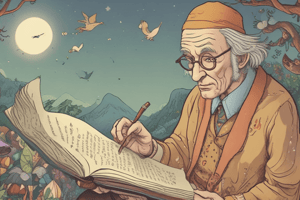Podcast
Questions and Answers
What is the special power that Matilda possesses?
What is the special power that Matilda possesses?
- Superhuman strength
- Invisibility
- The ability to fly
- Telekinesis, or the power to move things with her mind (correct)
Which character in the book is a used-car salesman?
Which character in the book is a used-car salesman?
- Miss Honey
- Bruce Bogtrotter
- Miss Trunchbull
- Mr. Wormwood (correct)
What is Mrs. Wormwood's main interest?
What is Mrs. Wormwood's main interest?
- Reading books with Matilda
- Helping Matilda with her telekinesis
- Cooking meals for her family
- Watching television and playing bingo (correct)
Who is the kind and patient teacher at Crunchem Hall?
Who is the kind and patient teacher at Crunchem Hall?
What is the author of the children's book Matilda?
What is the author of the children's book Matilda?
What is the occupation of Mr. Wormwood?
What is the occupation of Mr. Wormwood?
Why does Miss Trunchbull force Bruce Bogtrotter to eat an entire chocolate cake?
Why does Miss Trunchbull force Bruce Bogtrotter to eat an entire chocolate cake?
What is the name of Matilda's best friend at Crunchem Hall?
What is the name of Matilda's best friend at Crunchem Hall?
What is the outcome of Miss Trunchbull's visit to Miss Honey's class after Matilda uses her powers to make the glass of newt water spill?
What is the outcome of Miss Trunchbull's visit to Miss Honey's class after Matilda uses her powers to make the glass of newt water spill?
What is the relationship between Miss Honey and Miss Trunchbull?
What is the relationship between Miss Honey and Miss Trunchbull?
What is the primary setting of the story Matilda?
What is the primary setting of the story Matilda?
What is the theme of courage demonstrated by in the story Matilda?
What is the theme of courage demonstrated by in the story Matilda?
What is the consequence of Matilda's father's criminal business dealings?
What is the consequence of Matilda's father's criminal business dealings?
What does Matilda use her power to do in the climax of the story?
What does Matilda use her power to do in the climax of the story?
What is the resolution of the story Matilda?
What is the resolution of the story Matilda?
Flashcards are hidden until you start studying
Study Notes
Matilda by Roald Dahl
- Matilda is a children's book written by Roald Dahl and published in 1988.
- The book is about a girl named Matilda who has a rocky relationship with her parents and discovers she has the special power of telekinesis.
Characters in the Matilda Children's Book
- Matilda: a precocious little girl with exceptional intelligence and the power to move objects with her mind.
- Miss Honey: Matilda's kind and patient teacher at Crunchem Hall who recognizes her intellectual gifts.
- Miss Trunchbull: the cruel and unkind principal at Crunchem Hall who frequently punishes children for no reason.
- Mr. Wormwood: Matilda's disinterested and dishonest father who loves his less intelligent son, Michael, more.
- Mrs. Wormwood: Matilda's neglectful and shallow mother who prioritizes her appearance over her children.
- Bruce Bogtrotter: a portly boy who is punished by Miss Trunchbull for eating her chocolate cake.
- Hortensia: a prankster and Matilda's friend who educates her about Miss Trunchbull's punishments.
- Lavender: Matilda's adventurous and small-for-her-age friend at Crunchem Hall.
Matilda Book Summary
- Matilda is a gifted and neglected five-year-old who teaches herself to read at the age of three.
- She is enrolled in Crunchem Hall where she meets Miss Honey and Miss Trunchbull.
- Matilda discovers her telekinetic power and decides to use it to get revenge against her parents and Miss Trunchbull.
- She plays pranks on her father, gluing his hat to his head and bleaching his hair, and makes her family think their dining room is haunted.
- Matilda confides in Miss Honey about her power and they plot to get rid of Miss Trunchbull.
- Matilda writes a message on the blackboard, pretending to be the ghost of Miss Honey's father, ordering Miss Trunchbull to return her house and money.
- Miss Trunchbull is frightened and leaves, allowing Miss Honey to inherit her father's home and money.
- Matilda is promoted to a higher grade and loses her mind powers, but is happy and content with Miss Honey.
- Matilda's parents agree to let Miss Honey adopt her when they move to Spain to avoid persecution.
Analysis of Matilda
- The book explores the theme of magic through Matilda's power and her gifted intelligence.
- The story is told from a third-person point-of-view, focusing on Matilda's rocky relationship with her parents and her journey to harness her power.
- The main conflict involves adults being cruel to children, but Matilda learns to stand up for herself and others.
- The story's climax is when Matilda uses her power to rid the school of Miss Trunchbull, and the resolution is when Miss Honey adopts Matilda.
Themes in Matilda
- Courage: Matilda and Lavender display courage by standing up to Miss Trunchbull's abuse.
- Honesty: There are consequences for avoiding the truth, which Matilda's father learns.
- Family: Matilda's parents do not appreciate the value of children, but Miss Honey does.
- Youth: Children are primary characters in the book, and their worth is demonstrated by the author's description of their intelligence and uniqueness.
- Education: The value of a solid education is evident in Matilda's desire to learn.
- Good vs. evil: The triumph of good over evil occurs when Matilda rids the school of Miss Trunchbull and Miss Honey gets her house and money back.
- Power: The adults in the book underestimate the power of youth and honesty.
- Revenge: Matilda pranks her family and Miss Trunchbull as revenge for ignoring or yelling insults at her.
Studying That Suits You
Use AI to generate personalized quizzes and flashcards to suit your learning preferences.




